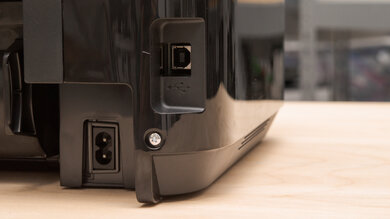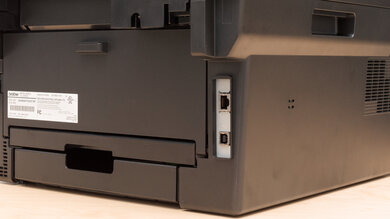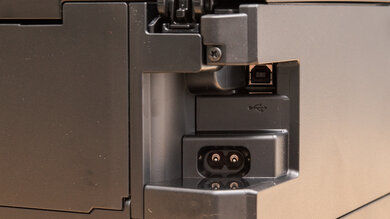- 10.0%Ethernet
- 10.0%USB Input To Computer
- 10.0%Bluetooth
- 20.0%Wi-Fi via Router
- 10.0%Wi-Fi Direct
- 10.0%External Storage Support
- 15.0%Apple AirPrint
- 15.0%Mopria Print Service
For many years, you could only connect your printer to your home computer by plugging it in with a wired connection. The parallel printer port was the industry standard for quite some time until USB was first introduced in the late 1990s. When wireless home networks started catching on the early 2000s, so did wireless printing. Bluetooth also started rolling in around that time and was the other wireless printing option for a while - until Wi-Fi Direct, Apple AirPrint, and Mopria Print Service made their debuts in the early 2010s.
As for commercial printers, not much has changed - Xerox PARC developed both the laser printer and Ethernet in the early 1970s, and the two have gone hand-in-hand ever since.
While all these different connectivity options can seem similar and confusing, they each have their advantages and drawbacks. There are few things more frustrating than a printer that won't work when you need it most, so knowing what each connectivity option does best, and struggles with, can help you figure out what matters most to you.
Our connectivity tests report the different connectivity options a printer has to help you find the best one for your needs. We look at whether the printer supports wired printing via Ethernet or with a USB cable, and also whether it can print wirelessly over a router's Wi-Fi network, Wi-Fi Direct, Bluetooth, AirPrint, or using the Mopria Print service. We also look at whether it has external storage support for flash drives or memory cards.
Test results
Our Tests
For physical connectivity inputs, we report what we find on the printer. For wireless connectivity options, we report what's included in the manufacturer's specifications for the model tested. Note that, at this time, we're not testing the actual performance of any of the different connectivity options, so we can't comment on whether the printer is easy to set up or maintains a stable connection, just which connection technologies it supports.
Ethernet
If you're a small business owner looking for a printer that your employees can all connect to securely, then you'll need something that supports Ethernet. By hooking up a printer to a router via Ethernet, all computers connected to the same router will be able to access it.
There are several benefits to printing over Ethernet. Sending files to print happens almost instantly, the connection is generally quite reliable, and a wired connection is more secure than a wireless one. Setting up your printer over Ethernet can take some time, however, especially if you're unfamiliar with wired networking.
This test checks whether the printer has an Ethernet port. If it does, then it gets a "yes" in this test, increasing the overall connectivity score. Note that we don't test the actual quality of the Ethernet connection itself.
USB Input to Computer
If you're looking for the simplest wired connection to your laptop or desktop PC, you'll want to make sure a printer has a USB input for connection to your computer. This way, all it takes is a USB cable plugged directly into your computer to get your files printed.
 USB port on the back of the Canon PIXMA MG3620
USB port on the back of the Canon PIXMA MG3620Printers generally use USB Type-B connectors, which aren't widely used in many other devices, so the cable you'll need is often just called a "printer cable." If you've never owned a printer before and don't have a USB-B cable lying around, you'll likely need to buy one separately since they're rarely included when you buy a new printer.
This test checks whether the printer has a USB input to connect to a computer. If it does, then it gets a "yes" in this test, increasing the overall connectivity score. Note that we don't test the actual quality of the USB connection itself.
Bluetooth
If you have a friend or family member over who needs to print but you don't want to deal with all the hassle of having to configure the printer again for someone who will likely only use it once or twice, then a Bluetooth-enabled printer comes in handy. It's especially convenient if you're printing from a phone or tablet that can't connect with a USB cable and you don't have access to a Wi-Fi network. If you're trying to connect from a laptop or desktop computer, though, you'll want to make sure it's Bluetooth-compatible first, since some aren't.
This test checks whether the printer is reported as Bluetooth-enabled. If Bluetooth support is listed in the manufacturer specifications, product manual, or is shown in the printer settings, then it gets a "yes" in this test, increasing the overall connectivity score. Note that we don't test the actual quality of the Bluetooth connection itself.
Like with any wireless connection, there are security risks to Bluetooth printing. An issue with Bluetooth, in particular, is that the security specifications of both the printer and your Bluetooth source can be tricky to find. We don't test this yet, so if you're printing sensitive information and are concerned about privacy, you may want to opt for a secured Wi-Fi network or a wired connection instead.
Wi-Fi via Router
If you plan on setting up your printer in range of a Wi-Fi network, you'll want to make sure it can connect to Wi-Fi via a wireless router. This is the most common way to connect a printer wirelessly to multiple computers in a shared space. Connecting a printer to a Wi-Fi network via a router is similar to connecting the printer via Ethernet, as the router acts as the intermediate between the printer and any connected devices. However, over Wi-Fi, there are no pesky cables in the way.
This test checks whether the printer can connect to a router's Wi-Fi network. We perform all our tests with this connectivity option when possible, so if we can successfully connect the printer to our lab's wireless network, then it gets a "yes" in this test, increasing the overall connectivity score. Note that we don't test the actual quality of the Bluetooth connection itself.
Wi-Fi technologies have their fair share of security concerns. Thankfully, there are more precautions you can take when you have control over your wireless network. If you're confident your router has been configured securely, you shouldn't have too much to worry about since most modern printers support connections over WPA2 secured networks; however, we don't yet have a test for this. When in doubt, disabling Wi-Fi and printing with a physical connection is always your safest bet.
Wi-Fi Direct
If your work requires you to be able to print receipts out of range of a Wi-Fi network, then it can be helpful to know if a printer supports Wi-Fi Direct. It's similar to Bluetooth printing, in that it lets you print if you don't have access to a wireless router, but it works a bit differently. It allows your printer to create a wireless network that any Wi-Fi-enabled device can connect to. It can be a bit of a hassle to set up, but you can send large files to print much faster and further than you can with Bluetooth.
This test checks whether the printer is reported as having Wi-Fi Direct. If Wi-Fi Direct support is listed in the manufacturer specifications, product manual, or is shown in the printer settings, then it gets a "yes" in this test, increasing the overall connectivity score. Note that we don't test the actual quality of the Wi-Fi Direct connection itself.
While Wi-Fi Direct creates a WPA2-encrypted network, you tend to have less control over the network than you would with a wireless router. It's worth taking a second to make sure the network is secured properly in the printer's settings, and that it has a unique passcode. Once Wi-Fi Direct is activated, you should find the new network listed in the available Wi-Fi networks on your device, usually under the printer's name. If your printer supports it, printing directly off a USB key is a good mobile solution when printing especially sensitive documents.
External Storage Support
If you're looking for something that can print directly from a memory card or flash drive, you'll want to check if your printer has external storage support. This is particularly useful if you want to print photos or documents on-the-go with very little setup required. Printing from an external storage device is also more secure than other mobile options since there's no need for a wireless network.
This test checks whether the printer has any type of external storage support. If it has a memory card slot or a USB input to connect external storage, then it gets a "yes" in this test, increasing the overall connectivity score. Note, however, that we don't test the input compatibility - a USB input may accept a flash drive but not a hard drive, for example.
Apple AirPrint
If you're living in the Apple ecosystem, AirPrint makes printing from your Mac, iPhone, or iPad a breeze. As long as your Apple device and AirPrint printer are connected to the same network, there are no additional drivers or software required to print. You can print seamlessly from Safari, Notes, Photos, or any other Apple app that supports AirPrint, but you'll still need access to a Wi-Fi network.
This test checks whether the printer is reported as AirPrint-enabled. If AirPrint support is listed in the manufacturer specifications, product manual, or is shown in the printer settings, then it gets a "yes" in this test, increasing the overall connectivity score.
Like with Bluetooth, it's difficult to find reliable information on the security specifications of AirPrint-enabled printers. Since we don't yet test this, you'll want to stick with a secured Wi-Fi connection or a simple USB cable if you're concerned about privacy.
Mopria Print Service
If Android is your OS of choice, you also have a wireless way to connect your printer using your phone or tablet thanks to the Mopria Print Service. Most new Android phones come with it preinstalled for seamless mobile printing as long as your phone and printer are both on the same Wi-Fi network. If your phone didn't come with it, you can also download it from the Google Play Store. Once downloaded, it becomes embedded in your device's printing options so you don't have to worry about having to hunt down the app every time.
This test checks whether the printer is reported as being compatible with the Mopria Print Service. If Mopria Print Service support is listed in the manufacturer specifications, product manual, or is shown in the printer settings, then it gets a "yes" in this test, increasing the overall connectivity score.
Similar to AirPrint, there's little information on the security specifications of printers that support the Mopria Print Service. Since we don't yet test this, use a secure Wi-Fi network or simply a standard printer cable if privacy is on your mind.
What's Missing?
There are a couple of things we don't yet test, like:
- Connectivity performance (connection reliability, transfer speed, etc.)
- NFC compatibility
- External storage compatibility (USB flash vs hard drive, SD card type, etc.)
- Ease of configuration
- Wireless security measures (WPA2 compatibility, Bluetooth security requirements, etc.)
- Phone line or fax inputs
Conclusion
Connectivity is one of the most important things to consider when shopping for a new printer. Wireless printing is convenient but can be a challenge to configure properly and securely. Setting up a wired connection tends to be pretty straightforward, but isn't possible with most mobile devices. The location it's set up in, the number of people who will be using it, and the types of devices they'll be printing with will affect which connectivity options are best. Knowing your needs is the first step towards helping you choose a printer with the right connectivity options. Once you've found something that works for you, keeping yourself familiar with the different connectivity options it supports will help take some of the guesswork out of troubleshooting any potential connection issues that may arise.


























